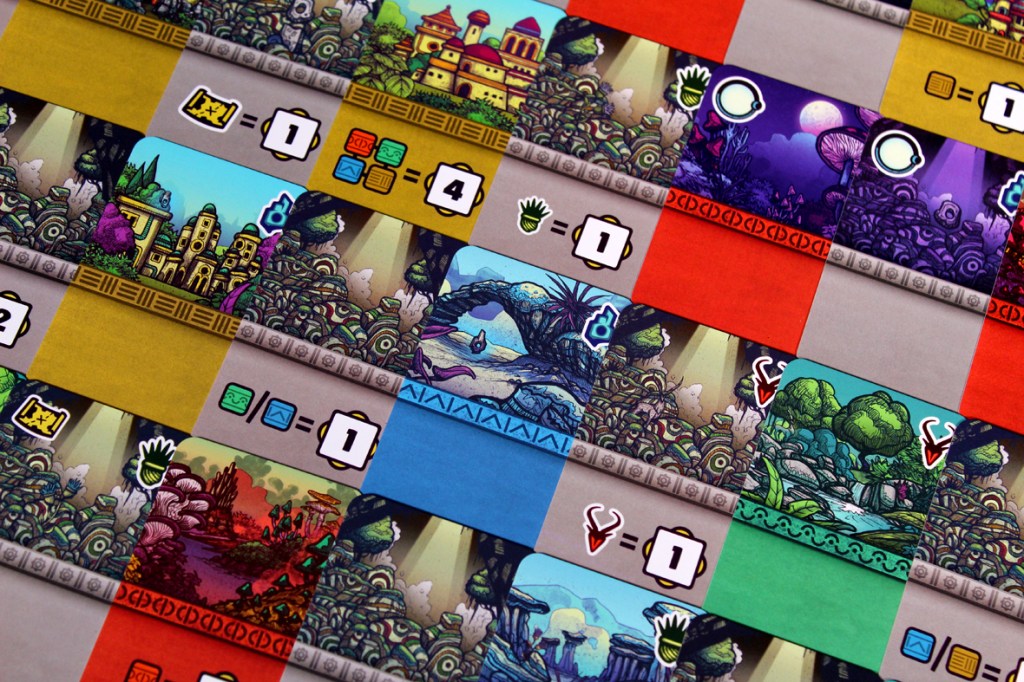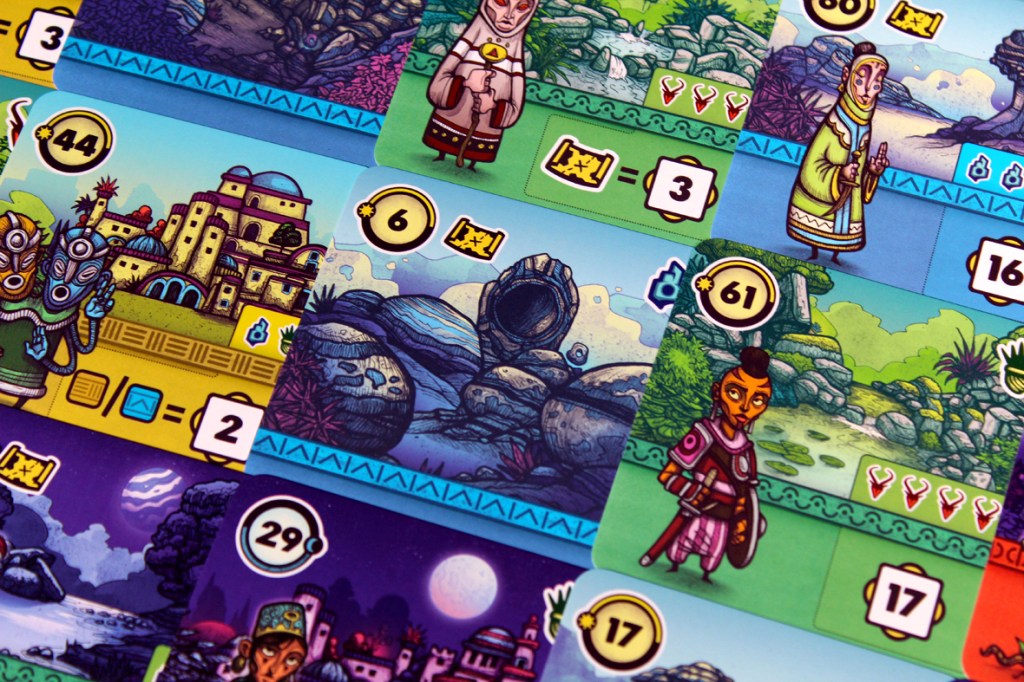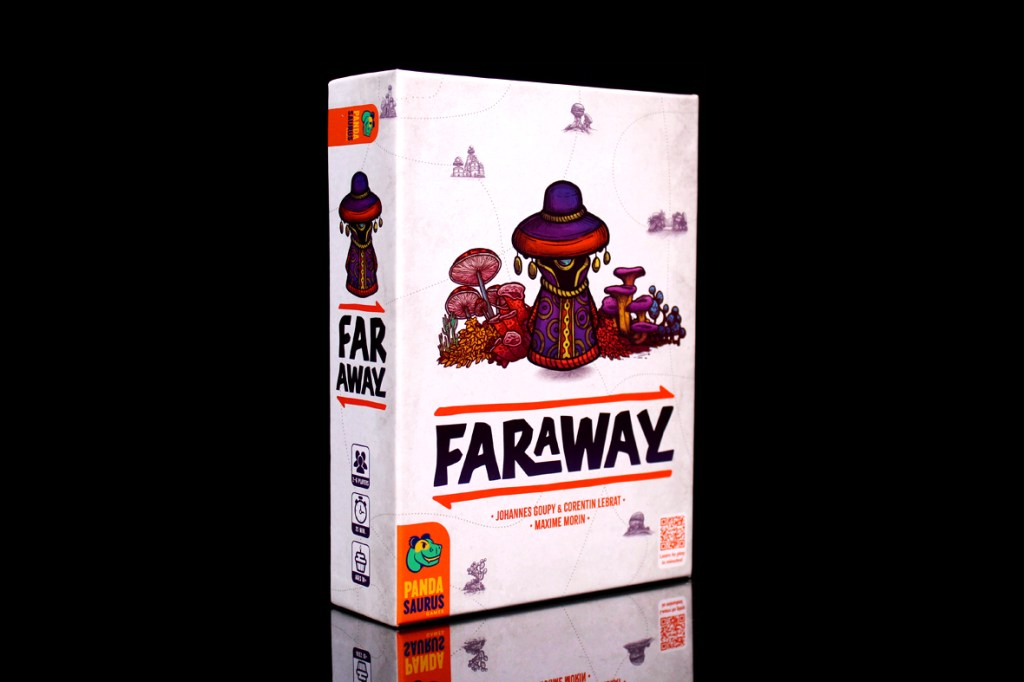
Base price: $25.
2 – 6 players.
Play time: 15 – 30 minutes.
BGG Link
Logged plays: 8
Full disclosure: A review copy of Faraway was provided by Pandasaurus Games.
Alright, we’re plugging away! I was going to write more this week, and then my friend accidentally told me she had never watched What We Do in the Shadows or The Good Place, and so in the process of rectifying that I haven’t had much time to get around to the writing that I wanted to do. But I digress. We’re consistently either ahead or behind or ahead again, so it comes and goes in waves anyways. Let’s check out Faraway, a new little card gaming coming from Pandasaurus Games!
In Faraway, players are exploring the distant continent of Alula, beyond the Sea of Mists. It’s got new people, new lands, and new stuff, and as a noted appreciator of stuff, you can’t wait to get your eyeballs on all of it. Go on an adventure where you have to walk back the way you came, exploring and finding treasure and meeting new friends who would like you much more if you gave them some of your treasure. That’s the dream. Also kind of nice of you since it seems like it really is their treasure that you’re picking up, anyways. Whose journey will yield the greatest wonder?
Contents
Setup
Almost no setup. All you do here is shuffle the Sanctuary Cards:
Then, shuffle the Region Cards:
Deal each player three of the latter, and reveal one per player plus one in the center. You should be ready to start!

Gameplay

Not a ton to worry about here, either. Here’s how it works. Over eight rounds, players will simultaneously place cards, potentially gain Sanctuary Cards, and then draw new ones.
To kick off a round, every player chooses a card from their hand and places it face-down in front of them. Then, all players reveal and add the card they played to the right of the last card they played (naturally, if it’s the first card you’ve played in the game, just start a row). I tend to do a two row, four column thing, but the game recommends all in one row. Whatever works.
If your card has a higher number in the top-left corner than the last card you played, you find a Sanctuary! All players who find a Sanctuary draw one Sanctuary Card, plus one more for each Clue Icon present in their play area. If you did not play a higher number, you do not gain any Sanctuary Cards, even if you have Clues present. Of those cards, each player gets to keep one.
Then, starting with the player who played the lowest number, each player chooses a card to draw to their hand from the center of the table. Do not draw new cards; players who go later in the turn have fewer options. In the final round, no new cards should be revealed (as no new regions will be played), but everyone still gets to keep one Sanctuary.

After eight rounds, the game ends! Flip every Region Card face-down (leaving Sanctuary Cards face-up), and, starting from right to left, reveal each card, scoring it based on whether or not you possess the required items. If a card scores, it scores based on the cards that are currently face-up. Then, score any Sanctuary Cards, if applicable. The player with the most points wins!
Player Count Differences
Not a ton, here! It’s a pretty standard shift in player count where you have a bunch of randomized cards that everyone chooses from. It just means at higher player counts, you’re slightly incentivized to play lower-value cards so that you can get a pick of the increasingly large draft. No big deal beyond that. Nothing you play, card-wise, can really affect other players; you mostly just work on building up your tableau and your Sanctuary Cards. As a result, not a huge difference in player count! More players might slow things down a bit, but not much beyond that.
Strategy
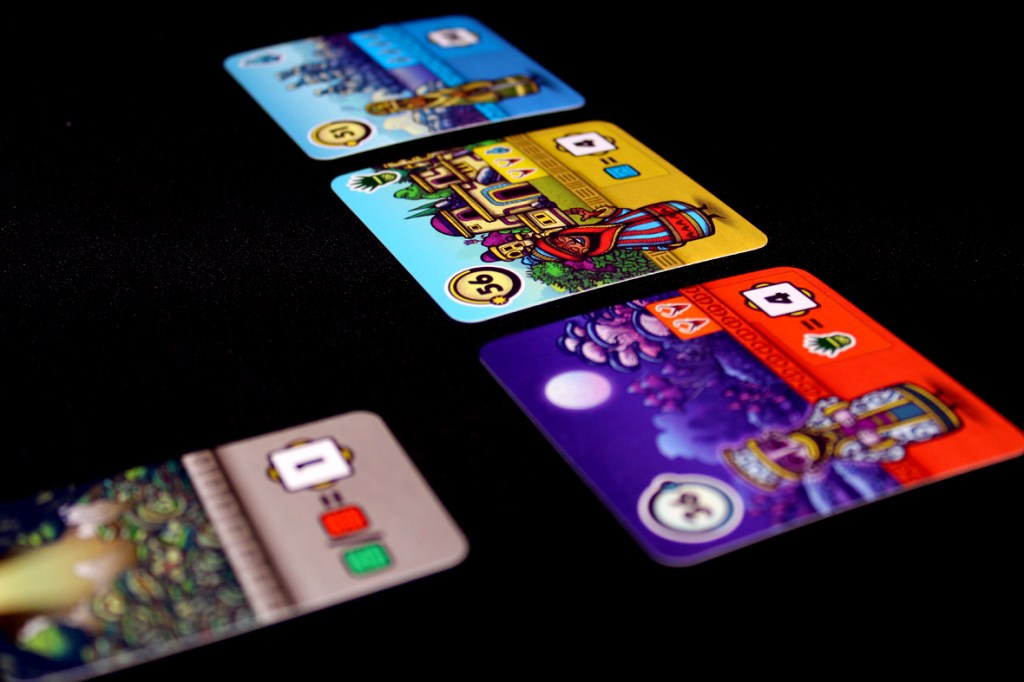
- Think about it in both directions! You really can’t expect to win the game by just consistently playing cards of increasing value. You might win, but it’s definitely not as likely. Instead, try to plan backwards so that you can play cards that you’ll be able to activate by placing their required cards later (so that when you activate your cards in reverse order, they’ll activate before your more valuable cards).
- Getting Sanctuary Cards is a pretty good way to fill gaps in your plans. You can’t always get all the symbols you need on the cards you draw, so leaning into Sanctuary Cards can give you a lot of options. That said, I wouldn’t expect to get more than five in a game, so choose wisely from your options.
- I tend to do two distinct low-to-high arcs. This lets me start back from the bottom (typically resource-rich cards) so that I can play things that will activate my higher-value (and higher-point) cards. The final cards I play tend to be cards that either activate from symbols on my Sanctuary Cards or are just worth points on their own.
- I try not to spread myself too thin on resource requirements. You’re unlikely to get four of each resource without a lot of luck, so maybe focus on one or two resource types! You don’t always need the pineapples.
- The one thing that works well for me is accruing a lot of Clue symbols. You can typically get cards that will reward you for having Clue symbols, and more Clue symbols lets you draw more Sanctuary Cards, which can help you get more Clue symbols and other resource types. It’s a virtuous cycle.
- If you’re really looking at what your opponents are taking, you might be able to do some hate-drafting. Can’t recommend it on principle, but if you see that your opponent needs blue cards or pineapples or something, you can always help yourself to that card when you’re drawing new Region Cards. They’ll resent you for it and you likely won’t be able to completely block them, but you can make them work for it.
- You also don’t really need the last few cards you take, either, so you can just kind of hoard or cover your bases. There’s plenty of time to hate-draft, but, also, if you have drafted the right cards earlier in the game, you might not really need any of the last few cards you take. They might be slightly better than what you have, and that’s always nice, but if you don’t need them, you can focus on denying your opponents what they need.
Pros, Mehs, and Cons

Pros
- This one has a fantastic color scheme. It’s one of the most pleasant I’ve seen in a while! Everything about the game is bright and colorful and engaging. Looks really good.
- Another nicely portable game. It may take up a fair amount of room to play, so I wouldn’t precisely call it a travel game, but it can be taken with you most places; the box isn’t too big.
- It’s pretty simple to teach, conceptually. You really want to play cards from lowest to highest, but you score the cards from right-to-left, so you need to be mindful of what cards will activate when they’re scored later. That’s most of it, honestly. It’s a nice, light, simple game.
- Plays pretty quick, too! Once you’ve got the hang of it, I’d be surprised if it took you 20 minutes, especially with two players. I could see six taking longer just with the post-round draft and everything.
- The art style is pretty pleasant as well. I like the various characters and locations, too.
- I appreciate the little bit of flavor in the rulebook about Alula; makes me kind of want to see more games with this theme. I like when games have their own interesting world created, but I’m always a bit sad if we abandon that world entirely when there could be more fun games themed around it. Hopefully we’ll get more games set in Alula.
Mehs
- So many square cards. Always the bane of my shuffling, just because once you rotate them wrong everything gets weird.
Cons
- I think that for a smallish game the scoring can be a little obtuse. The challenge is largely that a lot of players are going to miss the “you score your cards in reverse”, but even then, players may play cards with symbols they’ll need later thinking that all of their cards are revealed on scoring, not revealed in order from right to left. Just keep an eye out for those kinds of pitfalls when you’re explaining the rules and you can potentially avoid a lot of player frustration.
Overall: 7.5 / 10
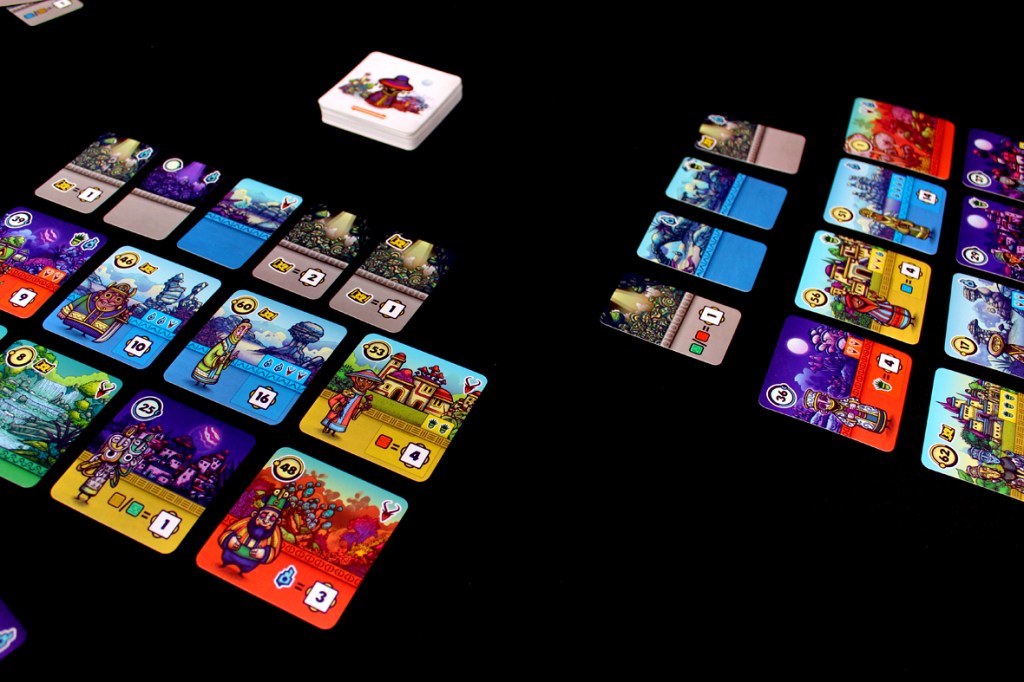
Overall, I think Faraway is a great little filler game! It’s quick and punchy, which I like, and the added twist of scoring in reverse order of cards played is fantastic. It’s a really interesting system where you have to make decisions with an optimistic hope that you draw the cards you need to make those decisions early in the game make sense in the late game, or rely on Sanctuary Cards to fill in the gaps (which may or may not work). It’s an optimization problem where you absolutely cannot have perfect information, which adds a nice bit of luck and makes for a few fun and entertaining swings. Granted, the first time I played, I completely missed the “score in reverse” thing, so I was the recipient of a particularly nasty surprise, and that’s largely been the case for folks I’ve played with as well, but once you play a game of it, you kind of get it, and it’s pretty straightforward after that. The trouble is that you might lose some players after the first game. But, for a lighter title, it’s got a lot going for it. It’s got a fun bit of worldbuilding, a good hook, and bright, boisterous art which really make the game inviting and appealing on the table. I generally think it’s pretty cool! I hope other games return to this world; it feels like there’s a lot to explore here. If you’re looking for a cool little filler game, you enjoy bright colors and fun art, or you’re not afraid to take big swings and hope for the best, you might enjoy Faraway as well! I’ve had a lot of fun with it.
If you enjoyed this review and would like to support What’s Eric Playing? in the future, please check out my Patreon. Thanks for reading!

